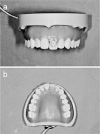Effects of mechanical properties of thermoplastic materials on the initial force of thermoplastic appliances
- PMID: 23035832
- PMCID: PMC8763061
- DOI: 10.2319/052512-432.1
Effects of mechanical properties of thermoplastic materials on the initial force of thermoplastic appliances
Abstract
Objective: To measure the forces delivered by thermoplastic appliances made from three materials and investigate effects of mechanical properties, material thickness, and amount of activation on orthodontic forces.
Materials and methods: Three thermoplastic materials, Duran (Scheu Dental), Erkodur (Erkodent Erich Kopp GmbH), and Hardcast (Scheu Dental), with two different thicknesses were selected. Values of elastic modulus and hardness were obtained from nanoindentation measurements at 28°C. A custom-fabricated system with a force sensor was employed to obtain measurements of in vitro force delivered by the thermoplastic appliances for 0.5-mm and 1.0-mm activation for bodily tooth movement. Experimental results were subjected to several statistical analyses.
Results: Hardcast had significantly lower elastic modulus and hardness than Duran and Erkodur, whose properties were not significantly different. Appliances fabricated from thicker material (0.75 mm or 0.8 mm) always produced significantly greater force than those fabricated from thinner material (0.4 mm or 0.5 mm). Appliances with 1.0-mm activation produced significantly lower force than those with 0.5-mm activation, except for 0.4-mm thick Hardcast appliances. A strong correlation was found between mechanical properties of the thermoplastic materials and force produced by the appliances.
Conclusions: Orthodontic forces delivered by thermoplastic appliances depend on the material, thickness, and amount of activation. Mechanical properties of the polymers obtained by nanoindentation testing are predictive of force delivery by these appliances.
Figures








References
-
- Eliades T, Eliades G, Brantley WA. Orthodontic brackets. In: Brantley WA, Eliades T, editors. Orthodontic Materials Scientific and Clinical Aspects. Stuttgart, Germany: Thieme; 2001. pp. 143–172.
-
- Boyd R, Miller RJ, Vlaskalic V. The Invisalign system in adult orthodontics: mild crowding and space closure cases. J Clin Orthod. 2000;34:13–15.
-
- Kim TW, Echarri P. Clear aligner: an efficient, esthetic, and comfortable option for an adult patient. World J Orthod. 2007;8:13–18. - PubMed
-
- Barbagallo LJ, Shen G, Jones AS, Swain V, Petocz P, Darendeliler MA. A novel pressure film approach for determining the force imparted by clear removable thermoplastic appliances. Ann Biomed Eng. 2008;36:335–341. - PubMed
MeSH terms
Substances
LinkOut - more resources
Full Text Sources
Other Literature Sources

